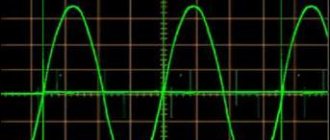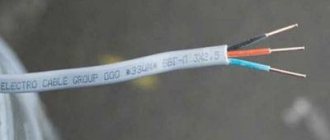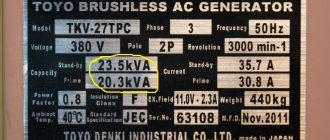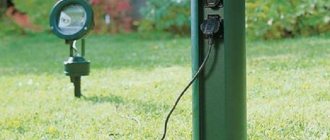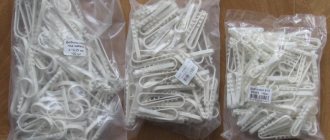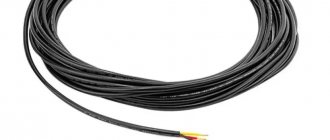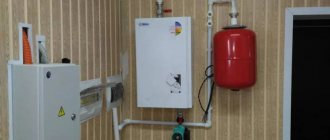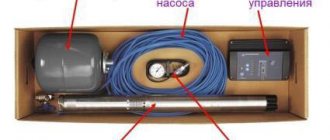Pressure
Pressure (p) expresses the force acting per unit area and is divided into static and dynamic pressure. The sum of these two pressures is the total pressure.
Static pressure is measured using a pressure gauge, exclusively when the liquid is still, or using a pressure tap installed perpendicular to the direction of flow, see Figure 2.3.
To measure total pressure, the pressure tap inlet should be positioned facing the direction of flow, see Figure 2.3. Dynamic pressure is defined as the difference between total and static pressure. This measurement can be made using a pitot tube.
Dynamic pressure depends on the velocity of the fluid. Dynamic pressure can be calculated using the following formula, in which the velocity (V) is obtained by measurement and the density (ρ) of the fluid is known:
Dynamic pressure can be converted to static pressure and vice versa. When flowing in an expanding pipe, dynamic pressure is converted into static pressure, see Figure 2.4. The flow in a pipe is called pipe flow, and the section of the pipe where the diameter of the pipe increases is called the diffuser.
Absolute and relative pressure
Pressure can be expressed in two different ways - as absolute or relative pressure. Absolute pressure is measured relative to absolute 0 and thus can only have a positive value. Relative pressure is measured relative to ambient pressure. Positive relative pressure indicates that the pressure is above barometric pressure, and negative relative pressure indicates that the pressure is below barometric pressure.
The definition of absolute and relative magnitude is also known from temperature measurements, where absolute temperature is measured in Kelvin (K) and relative temperature is measured in degrees Celsius (°C). Temperature in Kelvin is always positive and is measured relative to absolute 0. In contrast, temperature in degrees Celsius is measured relative to the freezing point of water (corresponding to 273.15 K), and can therefore be negative.
Barometric pressure is measured as absolute pressure. Barometric pressure varies with weather and altitude. Conversion from relative to absolute pressure is accomplished by adding the existing barometric pressure to the measured relative pressure.
In practice, static pressure is measured using three different types of pressure gauges.
- An absolute pressure gauge, such as a barometer, measures pressure relative to absolute 0.
- A standard pressure gauge measures pressure relative to atmospheric pressure. This type of pressure gauge is most often used.
- A differential pressure gauge measures the pressure difference between two pressure taps independent of barometric pressure.
How to determine the required pressure of the circulation pump
The head of centrifugal pumps is most often expressed in meters. The pressure value allows you to determine what hydraulic resistance it can overcome. In a closed heating system, the pressure does not depend on its height, but is determined by hydraulic resistance. To determine the required pressure, it is necessary to perform a hydraulic calculation of the system. In private homes, when using standard pipelines, as a rule, a pump that develops a pressure of up to 6 meters is sufficient.
You should not be afraid that the selected pump is capable of developing greater pressure than you need, since the developed pressure is determined by the resistance of the system, and not by the number indicated in the passport. If the maximum pressure of the pump is not enough to pump liquid through the entire system, there will be no circulation of liquid, so you should choose a pump with a headroom reserve
.
Pressure
The following pages present the various specifications.
The QH curve shows head (H) as a function of flow (Q). Flow (Q) is the volume of fluid passing through the pump per unit time. Flow is usually expressed in cubic meters per hour (m3/h), but formulas use cubic meters per second (m3/s). A typical QH curve is shown in Figure 2.5.
The QH curve for a given pump is constructed using the setup shown in Figure 2.6.
The pump starts and runs at a constant speed. When the valve is completely closed, Q is zero and H reaches its maximum value. As the valve is gradually opened, Q increases and H decreases. H is the height of the liquid column in the open pipe behind the pump. The QH curve is a sequence of points corresponding to pairs of Q and H values, see Figure 2.5.
In most cases, the pump pressure Dptot is measured, and the pressure H is calculated using the following formula:
The QH curve will be exactly the same if the experiment depicted in Figure 2.6 is carried out with a liquid whose density differs from the density of water. Thus, the QH curve is independent of the pumped liquid. This can be explained using theory, where it has been proven that Q and H depend on the geometry of the pump and the speed of rotation of the impeller, but not on the density of the pumped liquid.
The pressure rise in the pump can be measured in meters of water column (mH2O). The water meter is a unit of pressure and should not be confused with head, expressed in meters. As can be seen from the table of physical properties of water, with increasing temperature the density of water changes significantly. Thus, it is necessary to convert pressure to head.
Adjusting circulation pump speeds
Most circulation pump models have a function for adjusting the speed of the device. As a rule, these are three-speed devices that allow you to control the amount of heat that is sent to heat the room. In the event of a sharp cold snap, the operating speed of the device is increased, and when it warms up, it is reduced, despite the fact that the temperature in the rooms remains comfortable for staying in the house.
To change the speed, there is a special lever located on the pump body. Models of circulation devices with an automatic control system for this parameter depending on the temperature outside the building are in great demand.
Pump pressure - description of pump pressure
Total pressure
The total pump pressure is calculated as the sum of three components:
Static pressure
Static pressure can be measured directly using a differential pressure sensor, or pressure sensors can be installed at the pump inlet and outlet. In this case, the static pressure can be found using the formula:
Dynamic pressure
Dynamic pressure (the difference in dynamic pressure between the inlet and outlet of the pump) is determined by the following formula:
In practice, when testing a pump, the dynamic pressure and flow velocity at the pump inlet and outlet are not measured. Instead, the dynamic pressure is determined by a calculation method based on the fluid flow and the diameter of the pipe at the inlet and outlet of the pump:
As follows from the formula, the dynamic pressure is zero if the diameters of the pipe before and after the pump are the same.
Barometric pressure difference
The difference in barometric pressure at the points where the pressure sensors are installed at the inlet and outlet of the pump can be determined as follows:
Where:
Δz is the height difference between the installation points of the pressure gauge connected to the outlet pipe and the pressure gauge connected to the inlet pipe.
The barometric pressure difference is only significant if Δz is not zero. Thus, the position of the pressure taps on the pipe is not important in determining the barometric pressure difference.
If a differential pressure gauge is used to measure static pressure, the difference in barometric pressure is assumed to be zero.
Feeding performance of pumping equipment
This is one of the main factors to consider when choosing a device. Supply – the amount of coolant pumped per unit of time (m3/hour). The higher the flow, the greater the volume of liquid that the pump can pump. This indicator reflects the volume of coolant that transfers heat from the boiler to the radiators. If the supply is low, the radiators will not heat well. If the performance is excessive, home heating costs will increase significantly.
The power of circulation pumping equipment for a heating system can be calculated using the following formula: Qpu=Qn/1.163xDt [m3/h]
In this case, Qpu is the supply of the unit at the design point (measured in m3/hour), Qn is the amount of heat consumed in the area that is heated (kW), Dt is the temperature difference recorded on the forward and return pipelines (for standard systems this is 10- 20°C), 1.163 – indicator of the specific heat capacity of water (if another coolant is used, the formula must be adjusted).
Energy equation for ideal fluid flow
According to the energy equation for the flow of an ideal fluid, the sum of pressure energy, kinetic energy and potential energy is a constant. This equation is called the Bernoulli equation, named after the Swiss physicist Daniel Bernoulli.
Bernoulli's equation is valid under the following conditions:
- 1. Steady flow - does not change with time.
- 2. The liquid is incompressible - true for most liquids.
- 3. Flow without friction - friction losses are not taken into account.
- 4. Free flow - no supply of mechanical energy.
Formula (2.10) is used for a stream of liquid or the trajectory of a liquid particle. For example, the formula can describe the flow of liquid in a diffuser (2.10), but not the flow through the impeller, since the impeller supplies mechanical energy to the liquid.
In most applications, not all conditions for the energy equation are met. Despite this, the equation can be used for approximate calculations.
Checking the selected electric motor a. Checking the rudder shift duration
For the selected pump, look at the graphs of the dependence of the mechanical and volumetric efficiency on the pressure created by the pump (see Fig. 3).
4.1. We find the moments arising on the electric motor shaft at different steering angles:
,
where: M
α – torque on the electric motor shaft (Nm);
Q
mouth – set pump capacity;
P
α – oil pressure created by the pump (Pa);
P
tr – pressure loss due to oil friction in the pipeline (3.4÷4.0)·105 Pa;
n
n – pump speed (rpm);
η
r – hydraulic efficiency associated with fluid friction in the working cavities of the pump (for rotary pumps ≈ 1);
η
mech - mechanical efficiency, taking into account friction losses (in oil seals, bearings and other rubbing parts of pumps (see graph in Fig. 3).
We enter the calculation data in Table 4.
4.2. We find the rotation speed of the electric motor for the obtained torque values (based on the constructed mechanical characteristics of the selected electric motor - see paragraph 3.6). We enter the calculation data in Table 5.
Table 5
| α° | n, rpm | ηr | Qα, m3/s |
| 5 | |||
| 10 | |||
| 15 | |||
| 20 | |||
| 25 | |||
| 30 | |||
| 35 |
4.3. We find the actual pump performance at the obtained electric motor speeds
,
where: Q
α – actual pump performance (m3/sec);
Q
mouth – installed pump capacity (m3/sec);
n
– actual speed of rotation of the pump rotor (rpm);
n
n – nominal speed of rotation of the pump rotor;
η
v – volumetric efficiency, taking into account the reverse bypass of the pumped liquid (see graph 4.)
We enter the calculation data in table 5. We build a graph Q
α
= f ( α )
– see fig.
4 .
Rice. 4. Graph Q
α
= f ( α )
4.4. We divide the resulting graph into 4 zones and determine the operating time of the electric drive in each of them. We summarize the calculation in Table 6.
Table 6
| Zone | Zone boundary angles α° | Hi (m) | Vi (m3) | Qav.z (m3/sec) | ti (sec) |
| I | |||||
| II | |||||
| III | |||||
| IV |
4.4.1. Find the distance covered by the rolling pins within the zone
,
where: H i
– distance covered by rolling pins within the zone (m);
R o
– distance between the axes of the stock and rolling pins (m).
4.4.2. Finding the volume of oil pumped within the zone
,
where: V i
– volume of pumped oil within the zone (m3);
m
cyl – number of pairs of cylinders;
D
– plunger (rolling pin) diameter, m.
4.4.3. Find the duration of the rudder shift within the zone
,
where: t i
– average duration of rudder shift within the zone (sec);
Q
av
i
– average productivity within the zone (m3/sec) – taken from the graph in clause 4.4. or calculate from table 5).
4.4.4. We determine the operating time of the electric drive when shifting the steering wheel from side to side
t
lane
= t 1 + t 2 + t 3 + t 4 + t o
,
where: t
per – time of shifting the rudder from side to side (sec);
t 1 ÷ t 4
– duration of transfer in each zone (sec);
t o
– time to prepare the system for action (sec).
4.5. We compare t shift with T (time of shifting the rudder from side to side at the request of RRR), sec.
t
lane
≤ T
(30 sec)
Power
Power curves show power consumption as a function of supply, see Figure 2.7. Power is expressed in watts (W). Three types of power must be distinguished, see Figure 2.8.
- The power of the pumping unit transferred from an external source to the electric motor and controller (P1).
- Pump power transmitted by the electric motor to the shaft (P2).
- Net power transferred from the pump impeller to the liquid (P net).
Power consumption depends on the density of the liquid. Power curves are usually plotted for a standard liquid having a density of 1000 kg/m3, which corresponds to water at a temperature of 4°C. Thus, power measured on a liquid with a different density must be recalculated.
Typically, in ordering specifications, P1 is given for complete products, while P2 is given for pumps supplied with a standard motor.
Rotation frequency
Flow, pressure and power consumption vary depending on the pump speed. Comparison of pump characteristics is only possible if they are built for the same speed. It is possible to reduce the characteristics to the same speed using the equations below.
Speed control
By adjusting the pump speed, the QH, power and NPSH characteristics change. Recalculations of pump characteristics when its rotation speed changes are performed using similarity equations.
Subscript A in the equations indicates the original values, and subscript B indicates the modified values.
These equations allow us to obtain coherent points on the similarity parabola on the QH graph. The similarity parabola is shown in Figure 3.11.
Based on the relationship between the pump characteristic and its rotation speed, various control characteristics can be obtained. The most common control methods are the proportional control method and the constant pressure control method.
Types of power of the device for the well
When releasing devices, the manufacturer uses the following designations for power types:
- P1 (kW). Input electrical power is that which the electric motor takes from the electrical network.
- P2 (kW). On the shaft of the electric motor - the one that it gives to the shaft. The input electric power of pump P1 is equal to the shaft power of electric motor P2 divided by the efficiency of the electric motor.
- P3 (kW). The input indicator of the hydraulic pump is equal to the value P2 when the coupling that connects the shaft of the device and the shaft of the electric motor does not consume electricity.
- P4 (kW). The useful power of submersible hydraulic pumping equipment is that which comes out during operation in the form of water flow and pressure.
You can calculate the indicator online; there is a special calculator.
Efficiency
The efficiency of a pumping unit (ηtotal) is the ratio of useful power to the power of the pumping unit. Figure 2.9 shows the efficiency curves for a pump (ηuseful) and for a pumping unit including an electric motor and controller (ηfull). Hydraulic efficiency refers to P2, and pumping efficiency refers to P1:
The efficiency is always less than 100% because the power of the pumping unit is always greater than the useful power due to losses in the controller, motor and pump. The efficiency of the pumping unit (controller, electric motor and pump) is the product of the individual efficiencies:
The flow rate at which the pump has maximum efficiency is called the best performance point or QBEP.
NPSH - permissible cavitation reserve
Cavitation is the process of formation of vapor bubbles in areas where local pressure drops to the value of saturated vapor pressure. The degree of cavitation depends on how low the pressure in the pump is. During cavitation, pressure decreases and noise and vibration appear.
Cavitation first occurs in areas of lowest pressure in the pump, most often formed at the edges of the blades at the entrance to the impeller, see Figure 2.10.
The NPSH value is absolute and always positive. NPSH is measured in meters as head, see Figure 2.11. Since NPSH is measured in meters, there is no need to take into account the densities of different liquids.
There are two different values for NPSH: NPSHR and NPSHA.
NPSHA stands for available NPSH and determines how close to vaporization the liquid is in the suction line. NPSHA is determined by the formula:
NPSHR stands for required NPSH and expresses the lowest NPSH value required for acceptable pump operation. The absolute inlet pressure can be calculated from the given NPSHR value and the vapor pressure of the liquid by substituting NPSHR instead of NPSHA into formula (2.16).
To determine whether a pump can be safely installed in a system, the NPSHA and NPSHR for the highest flow and temperature values within the operating range should be found.
It is recommended to add a minimum safety margin of 0.5 m. Depending on the application, a larger safety margin may be required. For example, for noise-sensitive applications or for high-power pumps such as boiler feed pumps, the European Pump Manufacturers Association recommends applying a safety factor of SA=1.2 - 2.0 to the NPSH3% value.
The risk of cavitation in systems can be reduced or eliminated by the following measures:
- installing the pump lower than the liquid level in open systems;
- increasing pressure in closed systems;
- reducing the length of the suction line to reduce friction losses;
- increasing the cross-sectional area of the suction pipeline to reduce the speed of fluid movement and, as a result, reduce friction losses;
- elimination of local pressure drops resulting from bends and other obstacles in the suction pipeline;
- lowering the temperature of the liquid to reduce the vapor pressure.
The following two examples show how NPSH is calculated.
Example 2.1 Pump for supplying liquid from a well
The pump must supply liquid from a reservoir whose water level is 3 meters below the pump level. To calculate the NPSHA value, you need to know the friction loss in the suction line, water temperature and barometric pressure, see Figure 2.12.
Water temperature 40°C
Barometric pressure 101.3 kPa.
Pressure loss in the suction pipeline at the existing supply is 3.5 kPa.
At a water temperature of 40°C, the vapor pressure is 7.37 kPa and ρ is 992.2 kg/m3.
The values are taken from the table “Physical Properties of Water” at the end of the article.
For this system, the NPSHA expression in formula (2.16) can be written as follows:
Hsusp—water level relative to the pump. Hsuction can be above or below the pump and is expressed in meters. In this system, the water level is below the pump. Thus, Hsuction is negative, Hsuction = –3 m. The NPSHA value for the system is:
A pump designed to operate in the system under consideration must have an NPSHR value of less than 6.3 m minus a safety margin of 0.5 m. Thus, at the existing flow, the pump requires an NPSHR value less than 6.3 - 0.5 = 5.8 m.
Example 2.2 Pump in a closed system
In a closed system there is no free surface of water to use as a reference plane. This example shows how a pressure sensor located above the reference plane can be used to determine the absolute pressure in a suction line, see Figure 2.13.
Measured relative static pressure on the suction side pstat.in = -27.9 kPa. Thus, there is negative pressure at the pressure gauge installation point. The pressure gauge is installed above the pump. Consequently, the difference between the height of the pressure gauge and the height of the entrance to the impeller has a positive value Hinsu = +3 m. The speed in the pipe where the pressure is measured creates an additional dynamic pressure of 500 Pa.
Barometric pressure 101 kPa.
Calculated friction losses in pipes between the measuring point (pstat.in.) and the pump H pipe losses. = 1m.
System temperature 80°C.
Vapor pressure pn.p. = 47.4 kPa, density ρ = 973 kg/m3, values taken from the table “Physical properties of water”.
For this system, Formula 2.16 for NPSHA is:
Despite the negative pressure in the system, the NPSHA value for the existing flow rate exceeds 4 m.
Nominal head
Pressure is the difference between the specific energies of water at the outlet of the unit and at the entrance to it.
The pressure happens:
- Volume;
- Mass;
- Weight.
. Weight matters in conditions of a certain and constant gravitational field. It increases as the acceleration due to gravity decreases, and when weightlessness is present, it is equal to infinity. Therefore, the weight pressure, which is actively used today, is inconvenient for the characteristics of pumps for aircraft and space objects.
Full power will be used to start. It is supplied externally as the drive energy of an electric motor or with the flow of water, which is supplied to the jet apparatus under a special pressure.
Axial load
The axial load is the sum of the forces acting on the shaft in the axial direction, see Figure 2.14. The axial load is mainly caused by the pressure difference between the front and rear impeller disks.
The magnitude and direction of the axial load can be used to determine bearing size and motor design. Pumps with upward loads require fixed bearings. In addition to the axial load, it is necessary to take into account the forces acting on the shaft due to the pressure in the system. An example of an axial load curve is shown in Figure 2.15.
The axial load is related to the head and is therefore proportional to the square of the speed.
